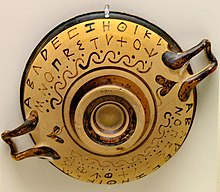Psi (Greek)
This article needs additional citations for verification. (May 2013) |
 | ||||||||||||||||||||||||||||||||||||||||||||||||
| Greek alphabet | ||||||||||||||||||||||||||||||||||||||||||||||||
|---|---|---|---|---|---|---|---|---|---|---|---|---|---|---|---|---|---|---|---|---|---|---|---|---|---|---|---|---|---|---|---|---|---|---|---|---|---|---|---|---|---|---|---|---|---|---|---|---|
|
||||||||||||||||||||||||||||||||||||||||||||||||
| History | ||||||||||||||||||||||||||||||||||||||||||||||||
| Use in other languages | ||||||||||||||||||||||||||||||||||||||||||||||||
| Related topics | ||||||||||||||||||||||||||||||||||||||||||||||||
| ||||||||||||||||||||||||||||||||||||||||||||||||

Psi /ˈsaɪ/ (uppercase Ψ, lowercase ψ; Greek: ψι psi [ˈpsi]) is the 23rd letter of the Greek alphabet and is associated with a numeric value of 700. In both Classical and Modern Greek, the letter indicates the combination /ps/ (as in English word "lapse").
For Greek loanwords in Latin and modern languages with Latin alphabets, psi is usually transliterated as "ps".
The letter's origin is uncertain. It may or may not derive from the Phoenician alphabet. It appears in the 7th century BC, expressing /ps/ in the Eastern alphabets, but /kʰ/ in the Western alphabets (the sound expressed by Χ in the Eastern alphabets). In writing, the early letter appears in an angular shape (![]() ).
There were early graphical variants that omitted the stem ("chickenfoot-shaped psi" as:
).
There were early graphical variants that omitted the stem ("chickenfoot-shaped psi" as: ![]() or
or ![]() ).
).
The Western letter (expressing /kʰ/, later /x/) was adopted into the Old Italic alphabets, and its shape is also continued into the Algiz rune of the Elder Futhark.
Psi, or its Arcadian variant ![]() or
or ![]() was adopted in the Latin alphabet in the form of “Antisigma” (Ↄ, ↃC, or
was adopted in the Latin alphabet in the form of “Antisigma” (Ↄ, ↃC, or